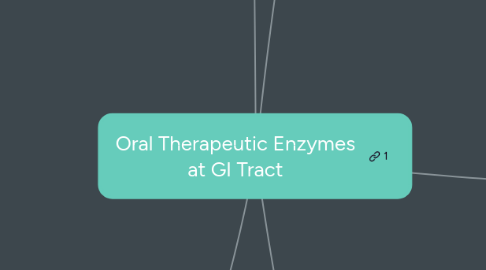
1. Exocrine Pancreatic Insufficiency
1.1. Problem caused by the disease
1.1.1. What
1.1.1.1. Absence of digestive enzyme such as amylase, protease, lipases
1.1.1.1.1. Frequent in Type 1 (51% prevalence) and type 2 (32% prevalence) diabetes
1.1.2. Caused by
1.1.2.1. Cystic fibrosis
1.1.2.2. Pancreatic cancer
1.1.2.3. Chronic pancreatitis (Main cause)
1.1.3. Impact
1.1.3.1. Insufficient digestion
1.1.3.1.1. Malabsorption/ malnutrition
1.1.3.1.2. Steatorrhea
1.1.3.1.3. Body weightloss
1.1.3.2. Conceal other GI disease
1.1.3.2.1. Making diagnosis challenging
1.2. Initial Solution
1.2.1. What
1.2.1.1. Supplementation with bovine and porcine pancreatic enzymes in gastro-resistant enteric coated (microspheres)
1.2.2. How
1.2.2.1. Protect enzyme and release them during transit to duodenum along side food
1.2.3. Potential Weakness
1.2.3.1. Therapeutic benefits are uncertain.
1.2.3.1.1. Coated and uncoated microsphere formulation with bioavailability fluctuate between products
1.2.3.1.2. Malnutrition persists in patients with pancreatic insufficiency
1.2.3.2. Varies with the primary cause of pancreatic insufficiency
1.2.3.2.1. Acidic conditions in the intestine can delay enzyme release and thus affect the clinical outcome of the therapy
1.3. Secondary solution
1.3.1. Mutant of Thermomyces lanuginosus lipase as enzyme replacement candidate
1.3.1.1. Possess resistance towards trypsin (with and without bile salts)
1.3.1.2. The variant is more stable at acidic pH
1.3.1.3. Increased refolding capacity compared to native lipase
1.3.2. Conjugation of synthetic polymers to enzyme
1.3.2.1. Overcoming the drawbacks: substitution therapy
1.3.2.1.1. Delivering the modified enzymes in the duodenum without prior dissolution of enteric coating
1.3.2.2. Feasibility Check: Lacking systematic analysis after oral administration
1.3.2.3. Expensive: Formulation of porcine pancreatic enzyme
2. Celiac Disease
2.1. Problems caused by the disease
2.1.1. Caused by
2.1.1.1. Triggered by the ingestion of cereal proteins (glutens)
2.1.2. Impact
2.1.2.1. Insufficient digestion of the proteins
2.1.2.1.1. Induces a T cell controlled autoimmune reaction precipitated in the small intestine of genetically-predisposed patients. Causing Inflammation
2.1.2.2. GI related symptoms
2.1.2.2.1. Diarrhea
2.1.2.2.2. Malabsorption
2.1.2.2.3. Abdominal pain
2.1.2.3. Non GI related symptoms
2.1.2.3.1. Osteoporosis
2.1.2.3.2. Anemia
2.1.2.3.3. Migraine
2.2. Initial Solution
2.2.1. Strict exclusion of gluten
2.2.1.1. Extremely difficult to be adhered
2.3. Oral administration of gluten-degrading enzyme (Promising solution, at clinical research phase)
2.3.1. Contains
2.3.1.1. Barley endoprotease (EP-B2)
2.3.1.2. Immunogenic characteristics
2.3.1.3. GI-resistant glutamine and proline-rich peptides of gluten with proline-specific endopeptidases (PEPs)
2.3.2. Issue faced
2.3.2.1. Sensitivity of some PEPs to acidic gastric conditions and their potential degradation by intestinal fluids and bile salts
2.3.2.1.1. PEPS being incorporated in enteric-coated capsules, avoiding inactivation [Simulation phase only, uncertain about human physiology]
2.3.2.1.2. Should be degraded in upper GI tract before jejunum
2.3.3. Solving the inactivation issue
2.3.3.1. PEPs mutants with increased enzyme stability (Protein Engineering)
2.3.3.1.1. By changes in canonical pepsin specificity pattern, replacement by phenylalanine and leucine
2.3.3.1.2. Hydrophobic packing, protecting the enzyme from pepsin attack
2.3.3.2. Conjugation go PEG to PEPs
2.3.3.2.1. PEGylated enzyme exhibit enhanced activity towards gluten peptide and improved stability in simulated condition
2.3.3.2.2. Conjugated PEPs to a dendronized cationic polymer, exhibiting prolonged retention and activity in stomach
3. Sucrose Intolerance
3.1. Problem caused by the disease
3.1.1. Unable to digest the disaccharide sucrose, resulting in malabsorption
3.1.2. Impact
3.1.2.1. Abdominal distention
3.1.2.2. Bloating
3.1.2.3. Diarrhea
3.1.2.4. Failure to thrive
3.2. Solution
3.2.1. Strict exclusion of sucrose [Practically difficult to follow]
3.2.2. Oral administration of yeast extract (on filled stomach)
3.2.3. Treatment with oral sacrosidase solution
3.2.3.1. Exceptionally resistant to acidic environments
3.2.3.1.1. Enzyme glycosylation
3.2.3.1.2. High concentration usage
3.2.3.2. Able to escape pepsin digestion under the presence of sacrificial protein substrates that compete for degradation
4. Lactose Intolerance
4.1. Problems caused by the disease
4.1.1. What
4.1.1.1. Deficit in lactase phlorizin hydrolase
4.1.2. Impact
4.1.2.1. Abdominal bloating
4.1.2.2. Alterations of bone mineral density (due to calcium deficiency)
4.1.2.3. Diarrhea
4.2. Solution
4.2.1. Excluding lactose-containing product
4.2.1.1. Drawbacks: Undersupply with calcium, phosphate and vitamin
4.2.1.2. β-galactosidase can be added to milk prior to consumption, administered directly with a lactose containing meal
4.2.2. Feasibility Check: β-galactosidase leads to reduced therapeutic efficiency
4.2.2.1. Caused by GU inactivation of the enzyme
4.2.3. Modified β-galactosidase: Branched 40-kDa PEG.
4.2.3.1. A hydrophilic polymer, creating steric hindrance zone around the enzyme
4.2.3.2. Ought to be controlled to prevent endogenous digestive catalysis
4.2.3.3. Exhibit enhanced stability at acidic pH and in simulated pepsin containing gastric fluid
4.2.4. Bioengineered β-galactosidase mutant and hydrolase from meso-acidophilic fungus demonstrated stability at low pH
4.2.4.1. Unknown viability (survival of hydrolysis by gastric and pancreatic enzymes)
5. Phenylketouria
5.1. Problem caused by the disease
5.1.1. Caused by
5.1.1.1. Defect in the gene encoding for phenylalanine hydrolase (PAH), which catalyze the phenylalanine to tyrosine
5.1.2. Impact
5.1.2.1. Making PAH non-functional
5.1.2.2. Phenylalanine accumulation
5.1.2.3. Impaired neurophysiological function and reduced cognitive development
5.2. Initial solution
5.2.1. Omitting phenylalanine from the diet, practically impossible and unable to reverse the neurological damage
5.2.2. Supplementary aids to the strict diet
5.2.2.1. Administration of tetrahydrobiopterin (a natural cofactor of PAH)
5.2.2.2. Enzyme replacement with phenylalanine ammonia lyase (PAL) or recombinant PAH
5.2.2.3. Gene therapy to restore PAH levels.
5.3. Solution targeted on PAL
5.3.1. Converts phenylalanine into trans-cinnamate
5.3.2. Produced recombinantly in yeast
5.3.2.1. Successfully tested after oral administration in mouse
5.3.3. [Improved Stability] PEGylated PAL (PAL-mPEG) conjugate
5.3.3.1. PAL to 5-kDA PEG produced therapeutically-relevant reduction of plasma phenylalanine levels
